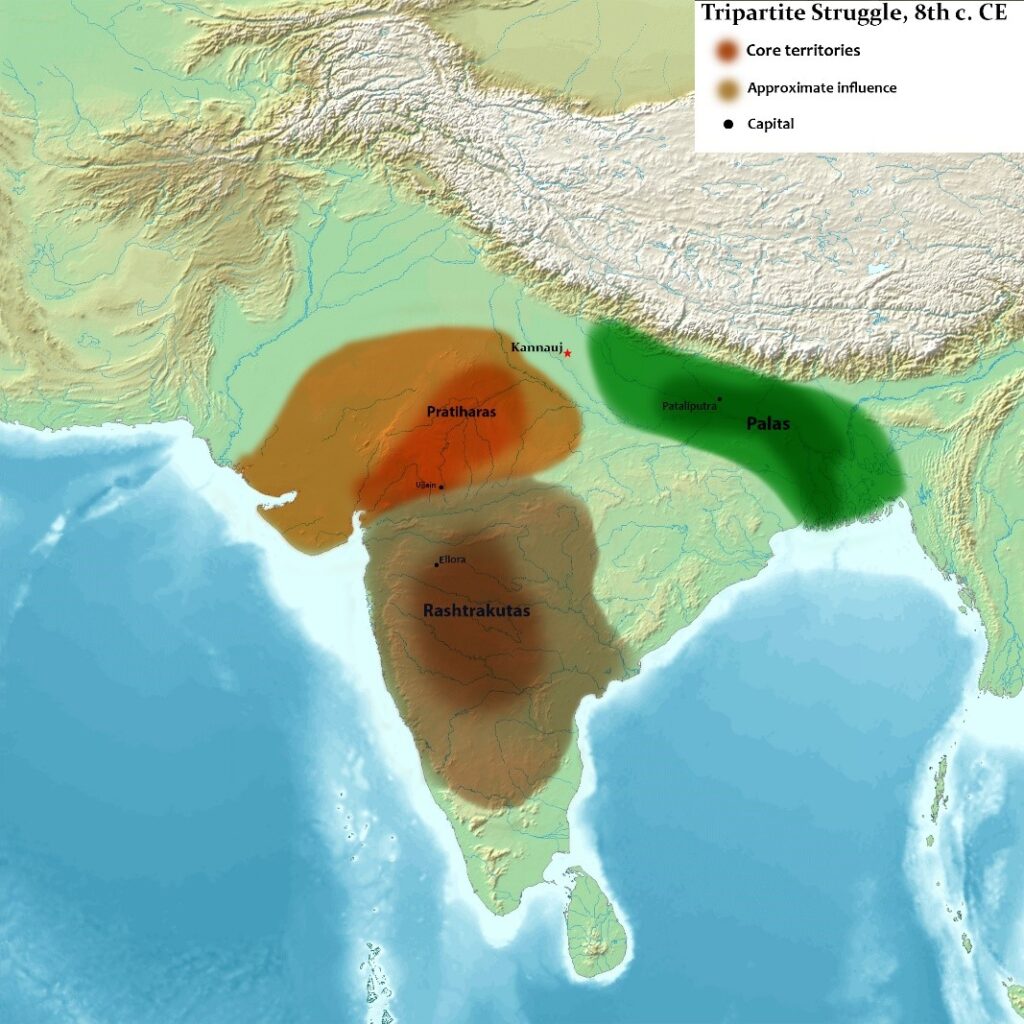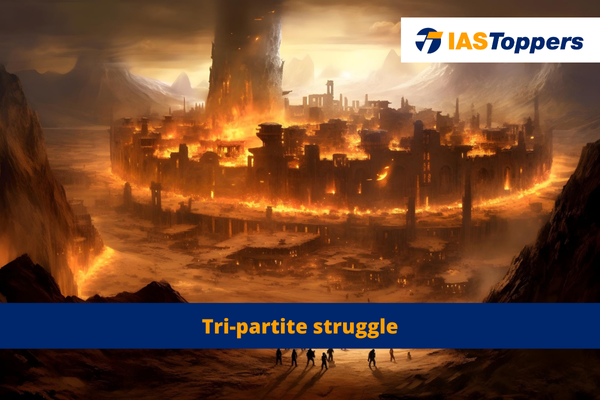The Tri-partite Struggle refers to a prolonged period of conflict in early medieval India, spanning over two centuries from the 8th to the 10th century. This historical conflict involved three major dynasties: the Gurjara-Pratiharas, the Rashtrakutas, and the Pala Empire, each aiming to control the strategically and economically vital region of the northern Indian subcontinent, particularly around the Kannauj area. In this article, you will learn about Tri-partite struggle, types, reasons for , etc.
This article will provide key insights for GS Paper- I Indian History of UPSC IAS Exam.
Table of Content
- What is Tri-partite struggle?
- Background of Tri-partite struggle
- History of Tri-partite struggle
- Course of Tri-partite struggle
- End of Tri-partite struggle
- Conclusion
- Frequently Asked Questions
What is Tri-partite struggle?
- In the ninth century, there was a big fight in northern India called The Tripartite Struggle or The Kannauj Triangle Wars.
- It involved 3 big empires- the Gurjara-Pratihara Empire, the Pala Empire, and the Rashtrakuta Empire.

Background of Tri-partite struggle
- The fight between Gurjara-Pratihara and Rashtrakuta started before they fought over Kannauj.
- These two empires shared a border in Gujarat and Malwa.
- This border kept changing, which made them enemies.
- Even before they fought over Kannauj, Dantidurga, who started the Rashtrakuta Empire, had beaten Nagabhata I of Gurjara-Pratihara.
- As stated in old inscriptions found at places like Ellora and Sanjan, Rashtrakuta king might have defeated the Gurjara-Pratihara king who ruled Avanti back then.
- On the other side, the fight between the Pala Empire and the Ayudha dynasty of Kannauj had been going on for a long time.
- It started in the 7th century between Harshavardhana and Sasanka and continued until the 12th century.
- Even though Vatsaraja and Nagabhata II tried to take Kannauj, Rashtrakuta Kings Dhruva and Govinda III stopped them. The city ended up under Pala control.
- But later, the Gurjara-Pratihara took over Kannauj during Mihir Bhoja’s time, and it became their capital until their empire fell in 1036 CE.
History of Tri-partite struggle
- After Harsha’s death in 647 A.D., not much is known about the kingdom of Kannauj.
- Arunasva briefly controlled Kannauj after clashing with Wang Hstian-tse, an ambassador from the Chinese emperor Tai-Tsung during King Harsha’s reign.
- Wang Hstian-tse managed to capture Arunasva and took him back to China to serve the Tang Emperor.
- Around AD 730, Yashovarman established his kingdom in Kannauj.
- Yashovarman invaded Gauda, which was later written about in a poem called Gaudavaho by his courtier Vakpatiraja in the 8th century.
- Following Yashovarman, three kings—Vijrayudha, Indrayudha, and Chakrayudha—ruled Kannauj from the late 8th century until the 820s.
- The Gurjara-Pratiharas of Bhinmal (Rajasthan), the Palas of Bengal and Bihar, and the Rashtrakutas of Manyakheta (Karnataka) fought each other for control over Kannauj.
- This conflict lasted for about two hundred years until Nagabhata II, the ruler of Gurjara-Pratihara, emerged victorious.
- Kannauj became the capital of the Gurjara-Pratihara state, which lasted for almost three centuries.
Course of Tri-partite struggle
- Dharmapala overcame Indraraja, the ruler of Kanauj, who served the Pratiharas, and placed Charkayudha as his own servant.
- Then, he convened a grand assembly at Kannauj, attended by kings of Bhoja, Matsya, Madra, Kuru, Yadu, Yavana, Avanti, Gandhara, and Kira.
- These kings accepted Chakrayudha’s rule in Kannauj, bowing respectfully with their crowns trembling.
- Pratihara’s Vatsaraja defeated Dharmapala near Prayag and captured Kannauj.
- However, Dhruva of Rashtrakuta defeated Vatsaraja, forcing him to seek refuge in the Thar desert, losing his kingdom temporarily.
- Dharmapala reclaimed Kannauj and reinstated Chakrayudha on the throne. Dharmapala emerged as the mightiest ruler in North India, declaring himself Uttarapathasvamin (“Lord of Northern India”).
- After Dhruva’s demise, Rashtrakuta’s power weakened due to a succession war.
- Nagabhata II, Vatsaraja’s son, restored the Pratihara kingdom, conquered Kannauj, and made Chakrayudha his vassal. He then assumed imperial titles after the conquest.
- Nagabhata II defeated Dharmapala near Munger but faced defeat by Rashtrakuta’s Govinda III before advancing into Bengal.
- Govinda III occupied Kannauj and gained acknowledgment from Chakrayudha and Dharmapala.
- He expanded the Rashtrakuta Empire into Lata and Malwa.
- After Govinda III’s departure, Dharmapala regained control over North India and remained the dominant ruler until his demise.
- His successors, Devapala, Mahendrapala, and Shurapala I, upheld Pala’s supremacy over North India and Kannauj until around 865 CE.
End of Tri-partite struggle
- Prathihara’s Mihir Bhoja, grandson of Nagabhata II, initially failed to conquer Kannauj but later succeeded during Narayanapala’s reign.
- He made Kannauj the Prathihara capital.
- Under Mahendrapala I’s rule, Pratihara reached its zenith but gradually weakened due to conflicts with Arabs, Palas, and Rashtrakutas.
- Rashtrakuta’s Indra III briefly occupied Kannauj from 914 to 916 CE.
- Despite Mahmud of Ghazni’s sack in 1018 CE, Kannauj remained under Pratihara control until King Yashpala’s death in 1036 CE.
Conclusion
The Tri-partite struggle for the control of the crucial region of Kannauj is a significant episode in the medieval history of India, illustrating the complexities of political dynamics and regional power struggles. This protracted conflict involved the Pratiharas, Palas, and Rashtrakutas, each aiming to assert dominance over northern India and especially over Kannauj, which was seen as a symbol of sovereign prestige.
The struggle not only highlights the military and strategic attempts of these empires to expand their territories but also reflects the cultural and economic importance of Kannauj as a center of art, learning, and commerce during the period.
Ultimately, the Tri-partite struggle resulted in the fragmentation and weakening of these dynasties, setting the stage for the emergence of other regional powers and providing a crucial backdrop for understanding the shifting political landscape of early medieval India.
Ref:Source-1
| Other Articles in History & Culture | |
| Indian Musical Instruments | Nagara Style Temple |
| Martial Arts of India | Dravida Temple Style (South Indian temple style) |
| Industrial Revolution | Tribes in India |
FAQs (Frequently Asked Questions)
What do you meant by tripartite struggle?
The Tripartite Struggle was a three-way struggle between the Pratihara Empire, the Pala Empire and the Rashtrakuta Empire.
Which king won the tripartite struggle?
This tripartite struggle ended in favor of the Gurjara-Pratihara ruler Nagabhata II who made Kannauj the capital of the Gurjara-Pratihara kingdom.


